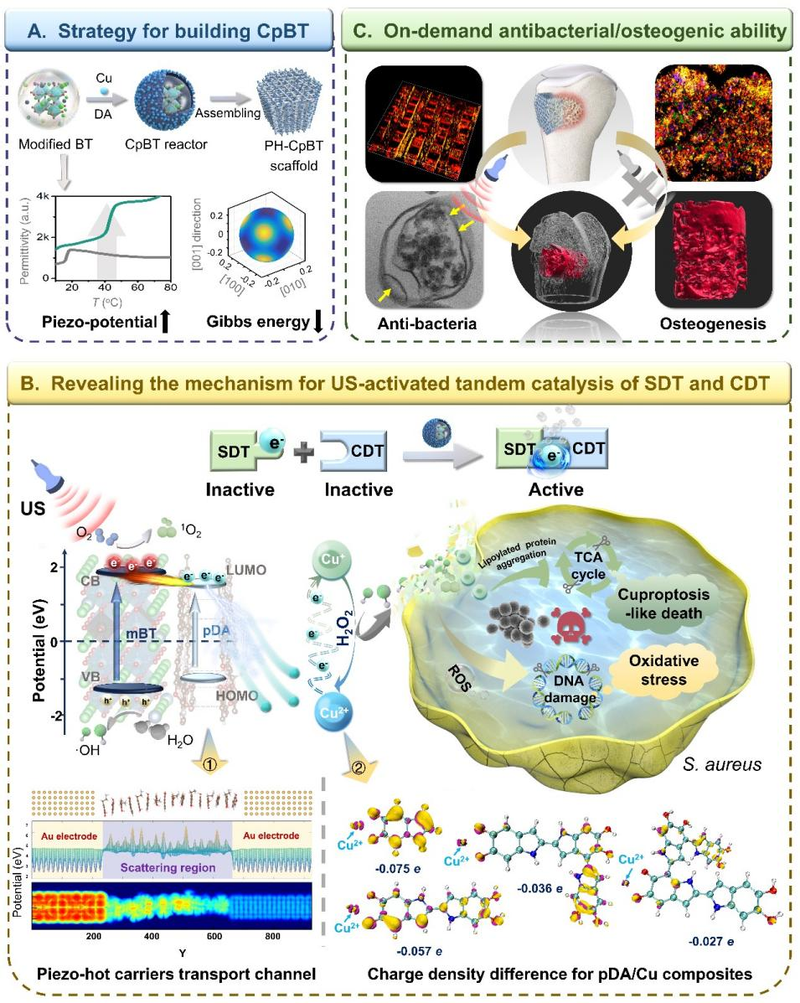Bone-implant-associated infections pose a serious challenge in medical healthcare. Microbes can tolerate antibiotics and evade the host’s defense system due to the accumulation of infectious bacteria in biofilms and their attachment on the surface of apparatuses or colonization in the surrounding tissues of the implants. Therefore, it is of great significance to develop bone implants with both anti-bacterial and osteogenic capacities.
To address the issue of bone implant infections, Professor Zhang Xianzeng’s team of College of Photonic and Electronic Engineering of FNU, have further proposed an ultrasound-activated piezoelectric intelligent nanoreactor based on their previous work on the ultrasound-piezoelectric regulation mechanism of piezoelectric sonosensitizers (Adv. Func. Mater., 2023, 33: 2210726). The nanoreactor amplifies the efficacy of sonodynamic and chemodynamic therapy on bacterial infections of bone implants through spatiotemporal ultrasound-driven tandem catalysis. By combining piezoelectric barium titanate with polydopamine and Cu ions, the ultrasound-activated piezo-hot carriers transfer easily to copper by “electron aspirator” polydopamine, which boosts reactive oxygen species production by piezoelectrics, and facilitates the interconversion between Cu2+ and Cu+ to promote hydroxyl radical generation via Cu+-catalyzed Fenton-like reactions. And the elevated reactive oxygen species cause bacterial membrane structure loosening and DNA damage. Therefore, the 3D-printed polyetherketoneketone bone scaffold engineered with the designed nanoreactor shows excellent antibacterial performance with ultrasound stimulation and promotes angiogenesis and osteogenesis on-demand in vivo with great clinical application potential. The strategy is expected to provide implants with ultrasound-regulated antibacterial and osteogenic capabilities, and offer a new approach for the treatment of implant infections.
The research results, entitled “Ultrasound-activated piezo-hot carriers trigger tandem catalysis coordinating cuproptosis-like bacterial death against implant infections,” have been published in the top journal Nature Communications. FNU is the first affiliation of the paper, with Dr. Huang Yanli of College of Photonic and Electronic Engineering as the first author, and Professor Zhang Xianzeng of FNU, Director Zhou Zongke and Dr. Wang Duan of West China Hospital of Sichuan University as the co-corresponding authors. Professor Wu Tianmin of College of Photonic and Electronic Engineering did the computational simulation for the paper. The research was supported by the National Natural Science Foundation of China and the Natural Science Foundation of Fujian Province.
Paper link: https://www.nature.com/articles/s41467-024-45619-y

(Translated by Huang Rui/ Reviewed by Xie Xiujuan)
